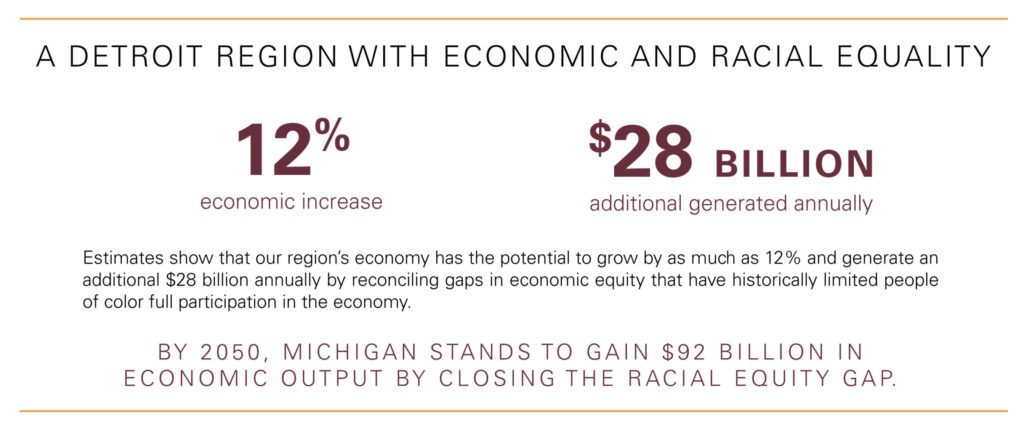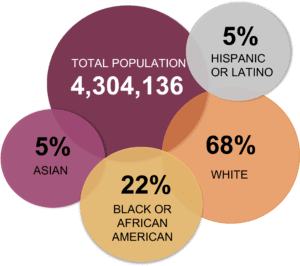The ideal Detroit region is an equitable and fair community where all people have the opportunities, resources, and tools needed to participate and prosper. To build a strong economy and drive economic growth, leaders in the private and public sectors need to advance racial equity. According to PolicyLink, estimates show that the region’s economy has the potential to grow by as much as 12% and generate an additional $28 billion annually by reconciling gaps in economic equity that have historically limited people of color from full participation in the economy. K.W. Kellogg Foundation reports that by 2050, Michigan stands to gain $92 billion in economic output by closing the racial equity gap.

As the conversation continues to move forward, data is key to determining how to close these gaps. The Chamber’s Data and Research team highlights how the region is doing on key measures of inclusive prosperity.
- Share of the Population
-
In 2020, Detroit region’s population was 68% white residents, with Black or African American residents accounting for 22%, and Latino or Hispanic and Asian residents at 5% each. The fastest-growing demographic in the Detroit region is Asian residents, which grew by 45%, followed by residents who identify (ethnically) as Hispanic or Latino (31%). The number of residents identifying as Black or African American (-2.6%) and white (-4.1%) decreased.

- Median Household Income
-
Inequities persist in household incomes by race and ethnicity in the Detroit region.
Median household income is a measure of economic well-being, and a strong indicator of economic equity in a region. The median household income for Black or African American households was $41,282 in 2021. The national average is almost double the household income of Black residents in the region. The income gap between Asian residents and Black residents is nearly $70,000 and the income gap between white residents and Black residents is nearly $35,000.
- Unemployment Rate
-
Black or African American workers continue to face high unemployment.
Unemployment rate measures the percentage of people over the age of 16 who aren’t working but are available and actively looking for work. In 2021, the Asian population in the Detroit region had the lowest unemployment rate (4.3%) and the Black or African American population had the highest unemployment rate (15.4%).
In 2021, the Black or African American population in the region was 9.1 percentage points higher than the national average (6.3%). Since 2016, all race and ethnicities have seen an increase in the annual unemployment rate. The largest increase in unemployment rate in the Detroit region since 2016 is the Hispanic or Latino population, which increased 2.3 percentage points from 7.3% (2016) to 9.6% (2022).
- Labor Force Participation Rate
-
Black or African American workers only group to increase labor force participation over past decade.
In the Detroit region in 2021, Black or African American workers had the lowest labor force participation rate at (59.8%) despite rising 2.4 percentage points over the past decade. Hispanic or Latino workers had the highest rate at (67.6%). Since 2011, labor participation rate for workers of all racial and ethnic groups have decreased, except for Black or African American workers.
Employment is the main source of income for working-aged people. Ensuring full employment would reduce racial inequities and poverty while boosting workers’ bargaining power and creating a stronger economy.
- Poverty Rate
-
Over the past five years, poverty rate in the Detroit region declined for all racial and ethnic groups.
The most notable declines in poverty in the Detroit region occurred in the Asian (5.5 percentage points) and Black (3 percentage points) populations. However, the Black or African American population has experienced poverty at the highest rate among other racial and ethnic groups. Almost 25% of Black residents are below the poverty line, 11 percentage points higher than the regional and national rate.
- Educational Attainment
-
Overall attainment for all racial and ethnic groups increasing, yet significant disparities persist.
In 2021, Asian adults in the Detroit region were most likely to hold a bachelor’s degree or higher among all racial and ethnic groups at 68.2%. The share of Black or African American adults with a bachelor’s degree or higher remains lowest in the region at 20.0%. However, Black adults with a bachelor’s or higher have increased from 18.5% since 2019.
- Homeownership Rate
-
Black or African American homeownership increasing, lags other racial groups significantly.
Homeownership can be a critical pathway to economic security and mobility. In 2021, Black or African American households in the region had the lowest homeownership rate at 46.4%, almost 34 percentage points lower than white residents’ homeownership rates. Overall homeownership rates increased for all racial and ethnic groups, along with the gap between white and Black households slightly improving since 2019. From 2019 to 2021, Hispanic or Latino households saw the largest increase of 4.8 percentage points, while the Black or African American population increased 3.0 percentage points, the Asian population 2.9 percentage points, and the white population 1.8 percentage points.
- Public Transit Commuters
-
Commute times via public transit double that of car commuters.
Public transit is critical infrastructure for commuters, and many residents rely on these systems to perform essential activities. Black or African American residents account for 72% of the total public transit commuters in the Detroit region. According to the Census, mean travel time to work in the region for public transit commuters is 53 minutes versus 25 minutes for car commuters. High commute time can put workers at a unique disadvantage, affecting job accessibility and attainability. Funding reliable and accessible transit leads to economic prosperity for all.
Source
U.S. Census, 2021 American Community Survey 1-Year Estimates

Learn how the Chamber is committed to racial justice and economic equity.













